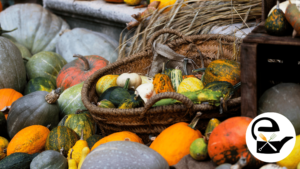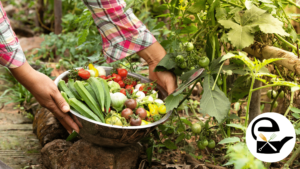Plan your Fall Garden
The autumn equinox in Setember kicks off the official start of FALL! And Pumpkin season! When light and darkness stand in balance with equal hours of night and day.
The darkness is gaining, and from now to Winter, the days get shorter. Boo!
It’s also a time of abundance when the bounty of the Earth must be gathered in and safely stored against the bleak times ahead, knowing that Winter is coming.
It doesn’t have to be that way…
Your fall garden can feel like a second spring harvest, and for many, it is surprising just how much you can plant, eat and enjoy from fall through Winter to the following spring!
What makes gardening great any time of year is that you can experiment with what works – what doesn’t, of course, enjoy all the delicious fruits and vegetables.
What should you keep in mind when planning a fall garden?

What type of soil is in Utah?
To get your best crop yet, you need to know a bit more about the soil type in Utah and what impact that has on what you want to grow.
Utah is known to have fine, sandy soil in many places, often described as poor quality, but that doesn’t need to stand in your way. So how can you get your soil ready to support your gardening efforts?
For Utah clay soil:
- Replace or mix the soil in your garden with some mixed soil or compost.
- Add gypsum to help break down some of the clay, so the roots can more easily grow. Add organic matter and mulch to cover the top layer of the soil; this will help to keep the soil moist.
For Utah sandy soil:
- Add compost when you are planting your seeds
- Fertilize often because sand doesn’t offer the proper nutrients for growing
- Add a high-quality mixed soil or good compost to the sandy soil
- Consider adding more compost when you start planting.
- Did I mention worm compost? Not sure where to start? Check out How to start a DIY Vermicomposting Bin.
You can use the USDA Plant Hardiness Map to determine which zone you are in to calculate the best time to plant.
Another handy tip is that on every seed packet, you will have an estimated harvest time frame; you can use this time frame to calculate when you sow seeds by using the state’s frost dates tool.
What is the second planting season?
Many people think that the only time you can plant seeds is in early springtime, but the second planting season is where you can get some of the most delicious fall veggies, which are ideal for putting cold hardy crops down.
- For cold-hardy vegetables, plant these from July to mid-august
- For semi-hardy vegetables, also known as half-hardy, about three weeks later.
What are cold season vegetables?
Cold season vegetables can handle some level of frost – and in fact, some vegetables thrive when faced with frost.
COOL SEASON: Average High Temp Between 35 and 65 Degrees Fahrenheit and Likely Chance of Frost.
The Winter season typically lasts from December through February; during these months, it is a good idea to check which plants will need extra coverage.
Cold hardy vegetable options for your Utah gardening adventures:
- Onions
- Cabbage
- Parsnips
- Kale
- Radish
- Turnips
- Green onions
- Rhubarb
- Arugula
Semi-hardy veggies for your Utah garden:
- Swiss chard
- Lettuce
- Carrot
- Radicchio
- Potatoes (check out this delicious recipe for when you get to harvest your crop: Instant Pot Potato Soup Creamy and loaded with vegetables. YUM!)
- Beets
- Rutabaga
It’s not just cold season veggies you can learn about; the more you know about what grows best all year through, the better prepared you will be year after year.

Which vegetables grow well in the Summer to harvest in Fall in Utah?
The veggies you choose to plant are just as crucial as getting your soil ready. While Utah is known to have some limitations when it comes to growing – due to the weather and the soil, many options will thrive!
So what are the best fruits and vegetables to plant in a Utah garden?
Eggplant
Eggplants grow great in Utah because they love the heat (like many of this list do!). The heat in the Summer makes Eggplants an excellent option for growing, and if you do see a little bit of rain, all the better. The best varieties to grow are Italian, Thai, and Fairy Tale.
Tip: be careful not to harvest your eggplant at the wrong time or fertilize them. Leave them without fertilizer, so you don’t compromise size or flavor. Harvest when shiny
Green Beans
Green beans grow gangbusters in Utah. If you are wondering why it is because they are multi-harvest veggies, they work well for those long dry summers. They’re not too thirsty, so they are ideal for novice gardeners.
Tip: Insects are the green bean’s enemy, so you’ll need to check and protect them often. Insects can destroy a whole crop before it has even flowered.
Green beans don’t grow well below 50 degrees, so plant this after the last frost. If you keep them well harvested, they’ll keep producing too. On average, you can expect to get some delicious beans to hit your plate after about 55 days.
Cucumbers
Cucumbers are typically considered a staple of the Summer but did you know they thrive in cold or heat? Depending on the variety you grow, you can harvest your cucumbers from late spring into late fall!
Keep in mind that cucumbers usually need a lot of space to grow well, so raised beds are ideal.
Tip: insects, rodents, and birds all love cucumber flowers, so make sure you protect them with netting when possible.
Squash
Ah, the most fall of vegetables is the delicious and versatile squash! Depending on when you plant it, you can harvest this tasty treat in May, although they thrive into November. Butternut, spaghetti, and zucchini make for an incredible fall harvest.
Tip: Plant your squash (well-spaced) next to carrots, beans, and tomatoes because they are great for cross-pollination.
Tomatoes
Most people start growing their veggies but sowing tomato seeds in pots in the kitchen, then moving on to bigger things.
Tomatoes are ultra forgiving when it comes to growing them, and the warmer it is, the bigger and juicer the tomato will be.
They can be grown vertically too, which is one of the things that helps gardeners save space.
Tip: tomatoes are prone to diseases, including fungus and blight – so the later into the Summer it gets, the more critical it is to keep an eye out.
Check out some of the juiciest tomato options for your gardening efforts: Tomatoes.
What should I plant in the fall in Utah?
Great question! Now you know some of the best veggies to harvest into late fall, here are some of the best ones to plant.
Tip: You can extend your growing seasons by cheating mother nature. If you buy seedlings already, you can give yourself up to a month’s head start. Setting up a cold frame can help protect your little seedlings too.
Tip: Eat the pea leaves & flowers in your salad! Mix them in your pesto to add extra sweetness. Yum!!
Carciferious: broccoli, Brussels sprouts, cauliflower, kohlrabi, rutabagas
Tip: Light frost won’t damage kohlrabi, cabbage, cauliflower, or broccoli.
The green veggies above, alongside carrots, peas, and beets, can have two growth cycles a year.
Since they are hardy, they can be planted in the early spring and then again in late Summer.
A slight frost doesn’t scare these guys!
If you prefer the magic that winter veggies bring, this post is for you: Winter Solstice For the All-Year Gardener: Learn how to harvest from your winter garden!
What makes planting in the fall so incredible is that it gives you access to deliciously fresh produce all Winter long – right in your backyard! Win-Win!!
Why should I spend time in the garden?
One of the best things about spending time learning what works and what doesn’t in your garden is that you will always have access to delicious herbs, veggies, and fruits. Food is Medicine! But, like all good things, it takes time to get the most from your space and time. Gardening is cheaper than therapy!
Get a head start by checking out the Upcoming Garden Workshops, or you can get a big helping hand that cares with my Begin your Kitchen GARDEN From Scratch with a Consultation.




